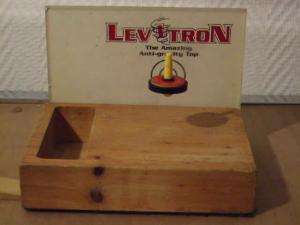Spin-stabilized magnetic levitation

Spin-stabilized magnetic levitation is a phenomenon of magnetic levitation whereby a spinning magnet or array of magnets is levitated via magnetic forces above another magnet or array of magnets, and stabilised by gyroscopic effect due to a spin that is neither too fast, nor too slow to allow for a necessary precession.
The phenomenon was originally discovered through invention by Vermont inventor Roy M. Harrigan in the late 1970s. Harrigan received a United States patent for his original levitation device based upon this phenomenon on May 3, 1983.[1][2] Independent of Harrigan, a Pennsylvanian inventor named Joseph Chieffo made the same discovery in 1984 employing a flat base magnet, a geometry that proved a significant advance over his predecessor's dished-base design. Chieffo's design, publicized in a 1991 edition of the periodical "MAGNETS IN YOUR FUTURE",[3] further differed from Harrigan's in its incorporation of an un-weighted top.[4][5] Harrigan's technology, either entirely or in conjunction with Chieffo's flat-base innovation, provided the basis for the development of a mass marketed levitating toy top sold under the brand name, 'Levitron'.
In 2012[6] and 2014[7] Max Michaelis reported operating Levitron brand magnetic tops at inclination angles of 45° and 90° (i.e. with the spin axis, horizontal).
Physics
Earnshaw's theorem does not allow for a static configuration of permanent magnets to stably levitate another permanent magnet or materials that are paramagnetic or ferromagnetic against gravity. This theorem does not apply to devices consisting of a properly configured magnetic base and corresponding magnetic top, however, because the non-static nature of the spinning top acts as a gyroscope to prevent its toroidal magnetic field from fully aligning itself in the same direction as that of the primary field of the magnetic base (i.e.: via the top flipping). This gyroscopic property combined with the top's precession allows it to respond dynamically to the direction of the local toroidally shaped field of its base magnet and remain levitating about a central point in space above the base where the forces acting on the top (gravitational, magnetic, and gyroscopic) are in equilibrium thereby allowing the top to rest in an energy minima well.[8] (see: magnetic levitation)
In the laboratory, experimental setups are able to levitate tops for indefinite periods by measuring the spin rate and maintaining it using a drive coil. However, variations in temperature can affect the stability, and without ambient temperature control the top will eventually fall after hours or days due to the temperature coefficient of the magnets.[8]
The physics of the magnetic stability is similar to magnetic gradient traps.[8]
Inclined or horizontal axis levitation is accomplished by superposing a “macro-trap” on the precessional “micro-trap” first described by Sir Michael Berry[9] and Simon, Heflinger and Ridgway.[8] The macro-trap is generated by a combination of two magnetic “V”s as well as a puller magnet, situated directly above the Levitron. The puller acts like the string of a pendulum.
References
- ↑ U.S. Patent 4,382,245
- ↑ Theodore Gray. "Ignorance = Maglev = Bliss". How2.0. Popular Science. Retrieved 2015-02-28.
This spinning top, which hovers above a magnetic base, was patented in 1983 by a Vermonter named Roy Harrigan.
- ↑ "MAGNETS IN YOUR FUTURE".
- ↑ Rod Driver (1999-09-22). "An amazing invention, and a patent failure (Part 1 of 2)". The Providence Journal. Archived from the original on 2001-03-06.
- ↑ Rod Driver (1999-09-23). "The patent that failed its invention (Part 2 of 2)". The Providence Journal. Archived from the original on 2001-03-06.
- ↑ M.M.Michaelis. Inclined Levitron experiments. Am.J.Phys. 80, 949-954, 2012
- ↑ M.M.Michaelis. Horizontal axis Levitron – a physics demonstration.Phys.Educ. 49(1), 67-74, 2014.
- 1 2 3 4 Martin D. Simon, UCLA Department of Physics, Lee O. Heflinger, S. L. Ridgway (1997). "Spin stabilized magnetic levitation". American Journal of Physics. Retrieved 2006-12-06.
- ↑ M.V.Berry. The Levitron. An adiabatic trap for spins. Proc.Roy.Soc. London Ser A 452,1207-1220, 1996